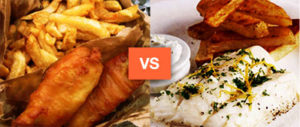Lent: Time for the Friday Fish… Bake?
Posted in Health & Wellness on March 3, 2014
 As you peruse the local listings for a fish fry near you this Lenten season, take a closer look at the menu. While fried fish is tasty, you might want to opt for a baked entrée.
As you peruse the local listings for a fish fry near you this Lenten season, take a closer look at the menu. While fried fish is tasty, you might want to opt for a baked entrée.
According to a study published in an American Heart Association journal, the risk of developing heart failure was lower for those who frequently ate baked or broiled fish, but higher for those who ate more fried fish.
“Not all fish are equal, and how you prepare it really matters,” said Donald Lloyd-Jones, MD/ScM, Chair of the Department of Preventive Medicine at Northwestern University and senior author of the study. “When you fry fish, you not only lose a lot of the benefits, you likely add some things related to the cooking process that are harmful.”
The study revealed that increasing your intake of baked and broiled fish may lower the risk of heart failure, while eating one serving of fried fish a week increased the risk of heart failure 48 percent. The researchers also found that dark fish, such as salmon, mackerel and bluefish, were associated with a significantly greater risk reduction than either tuna or white fish (sole, snapper and cod).
Thankfully, many fish fry organizers have adapted their menus to include healthy choices. Look for baked or braided salmon and consider filling your plate with fresh veggies or a baked potato instead of fries.
Heart Failure
Heart failure happens when the heart cannot pump enough blood and oxygen to support other organs in your body. According to the CDC, about 5.1 million people in the United States have heart failure and one in 9 deaths in 2009 included heart failure as contributing cause.
Although there is no cure for heart failure, lifestyle changes including a heart-healthy diet that’s low in saturated fat, trans fat, cholesterol and sodium can help slow the disease’s progression and improve everyday living.
Heart-Healthy Cooking Tips
March is National Nutrition Month®, and the Academy of Nutrition and Dietetics recommends eating fish regularly. To lower your risk of heart disease or to manage your existing disease, try these tips when preparing fish:
Limit Fat, Especially Saturated and Trans Fat
- Instead of frying, try baking, broiling, poaching or grilling
- Use liquid vegetables oils and soft margarine instead of stick margarine or shortening
- Limit consumption of French fries as they tend to be high in trans fats
- Avoid products containing partially hydrogenated oils
- Use a small amount of oils such as canola, olive and soybean in recipes and for sautéing
Eat Foods Containing Omega-3 Fatty Acids
- Select oils that provide omega-3 fatty acids, such as canola, flaxseed or soybean oil
- Eat two 4-ounce portions of fatty fish each week, like salmon, lake trout, albacore tuna (in water, if canned), mackerel and sardines
Reduce Salt (Sodium)
- Prepare foods at home so you can control the amount of salt in your meals
- Use as little salt in cooking as possible. You can cut at least half the salt from most recipes
- Add no additional salt to food at the table
- Select reduced-sodium or no-salt-added canned soups and vegetables
- Season foods with herbs, spices, garlic, onions, peppers and lemon or lime juice to add flavor
National Nutrition Month® is a nutrition education and information campaign sponsored annually by the Academy of Nutrition and Dietetics. The campaign is designed to focus attention on the importance of making informed food choices and developing sound eating and physical activity habits. For more information, visit www.eatright.org.
Source:
Rashad J. Belin, Philip Greenland, Lisa Martin, Albert Oberman, Lesley Tinker, Jennifer Robinson, Joseph Larson, Linda Van Horn, and Donald Lloyd-Jones. Fish Intake and the Risk of Incident Heart Failure: The Women’s Health Initiative. Circulation: Heart Failure, 2011; DOI: 10.1161/CIRCHEARTFAILURE.110.960450